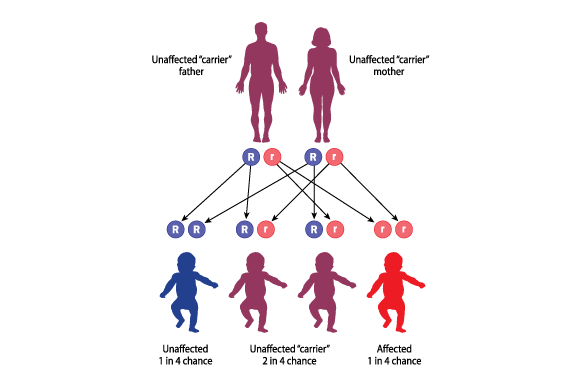The hereditary material in our body’s cells, DNA, contains all the instructions required for the construction and functioning of the human body. The entire amount of this genetic material, present in nearly every cell in our body, is called the "human genome" and comprises about three billion DNA base pairs.
Twenty years ago, in 2003, a significant milestone in genetic research was achieved with the completion of the Human Genome Project - a monumental endeavor for its time - in which scientists worldwide collaborated to map the entire sequence of base pairs in the human genome. Over the years, additions and corrections have been made to the sequence, thanks to numerous advancements in research tools, methods, and approaches.
However, the term "the entire base pair sequence of the human genome" is a misleading term, as there is no single, unique sequence. Even among healthy individuals, we find significant differences between their DNA sequences. These differences are one of the main factors responsible for the variations between individuals, making us distinct from one another.
Therefore, extensive research is required to understand which uncommon DNA sequences are linked to genetic diseases and disorders and which sequences, although different from the norm, do not cause hereditary diseases or impair function. Presently, over ten thousand diseases and disorders are known to be caused by a modification in a single gene. However, many sequences differ from the common versions of the same DNA region, and it is still unclear whether these differences have an effect, and if so, what it is.
6 View gallery


The inheritance of recessive genetic diseases, such as cystic fibrosis. The probabilities of parents who are carriers to have healthy or sick children
(Photo: Blamb, Shutterstock)
What is a hereditary disease?
A hereditary disease or syndrome is caused by specific sequences of hereditary material passed from parent to offspring. Many mistakenly believe that a “hereditary disease” and a “genetic disease” are the same, but it is important to understand that not all genetic diseases are hereditary. The term “genetic disease” commonly describes diseases originating from a single modification in a gene or chromosome. The defective gene or chromosome may be inherited from the parent, making it a hereditary disease. However, the defect could also arise during life.
For example, Down syndrome is a genetic disorder that is not inherited from the parents in the vast majority of cases. It is caused by an abnormal number of copies of chromosome 21: instead of the normal two copies (one from each parent), individuals with Down syndrome have three copies of this chromosome. This alteration usually occurs during the formation of the parent's sex cells (sperm or egg), so the parents themselves do not have Down syndrome, making it a non-hereditary genetic disorder.
Many types of cancer are caused by DNA sequences that are not present in the parental genomes, and are instead formed during life, causing increased cell division and leading to cancer. Such alterations can result due to factors such as radiation, tobacco smoking, certain viruses, asbestos exposure, and more.
In contrast, examples of hereditary diseases passed from parents to children include cystic fibrosis, Duchenne muscular dystrophy, and some forms of breast cancer.
If a disease is hereditary and caused by a modification in a single gene, it can manifest in several primary forms. Let's explore them.
An individual’s genetic material is organized in twenty-three chromosome pairs: one pair of sex chromosomes and twenty-two pairs of autosomes. Each chromosome contains regions with genes, which are sequences of instructions for producing specific active molecules, primarily proteins. The genes located on the twenty-two autosome pairs exist in two copies: one received from the mother and one from the father.
A hereditary disease with an underlying gene located on one of the twenty-two autosomes is accordingly called an autosomal disease. If the disease-causing gene is dominant, having one copy of the defective gene variant in your cells is enough to cause the disease, even if the other copy of the chromosome is normal.
Such a disease would be called a dominant autosomal disease. If the gene for the disease is recessive, it will cause the disease only if there are two copies of this gene variant in your cells, one on the maternal and one on the paternal copy of the chromosome. Such a disease is called a recessive autosomal disease.
Beyond these twenty-two pairs of chromosomes, there are also sex chromosomes. In humans, females have two copies of the X chromosome, while males have one X and one much shorter Y chromosome. Defective genes located on the X chromosome cause several hereditary diseases and impairments, including color blindness, and G6PD enzyme deficiency. Most of these diseases are recessive, meaning they will be expressed only in the absence of a proper copy of the gene.
Since females have two X chromosomes, they will only suffer from these conditions if they receive the disease-causing gene variant from both parents. Males have only one X chromosome, and therefore one defective copy is sufficient to cause a disease. Hence, color blindness and other diseases caused by defective gene variants located on the X chromosome, are significantly more prevalent in men than in women. Such diseases are called “sex-linked inherited diseases.
In conclusion, every hereditary disease is a genetic disease, but not all genetic diseases or disorders are hereditary. All genetic diseases are caused by defects in the hereditary material, but not all of these defects are hereditary; some arise during the formation of sex cells that later form the developing embryo, or during an individual's lifetime. Finally, many diseases, including type 2 diabetes, various autoimmune diseases, and certain birth defects, are influenced both by genetic alteration and environmental factors. In fact, most diseases have some hereditary component.
6 View gallery


The defective gene causing the disorder is located on the X chromosome. A child undergoing testing for color blindness
(Photo: Chomplearn, Shutterstock)
How is a genetic disease diagnosed?
Diagnosing a genetic disease primarily falls within the expertise of a geneticist. The diagnostic process typically involves an extensive evaluation comprising three parts: a physical examination, a detailed review of family history, and genetic testing in a laboratory, where feasible. Certain “red flags” may raise suspicion of a hereditary disease, such as its occurrence in multiple family members, particularly first-degree relatives; repeated miscarriages; repeated stillbirths; and instances of natural death at infancy.
Additional clinical symptoms often typical of genetic diseases include developmental delays, intellectual disability, and congenital anomalies. The presence of multiple clinical symptoms in an individual, such as a combination of intellectual disability, distinctive facial features, and a heart defect, may strongly suggest a genetic disorder like Down syndrome, as previously mentioned.
6 View gallery


A genetic syndrome that in the vast majority of cases is not inherited from the parents. A baby with Down syndrome
(Photo: Eleonora_os, Shutterstock)
Genetic testing
Genetic testing may be required under several conditions: when a person has a disease they wish to diagnose and determine if it is hereditary; when a couple is about to have a baby and wants to know if they are at risk of having children with a genetic disease or defect; when an individual has a family history of cancer and wishes to know if they are at increased risk; when a patient has cancer and doctors need to examine the genetic basis of the disease to adjust in tailored treatment approaches; and more.
Several methods are used to perform genetic tests in a laboratory, depending on the type of disease: cytogenetic tests, which examine the chromosomes; biochemical tests, which assess protein activity; and molecular tests, which analyze DNA sequences.
6 View gallery


Genetic screening can significantly reduce the risk of having children with birth defects or genetic diseases. A molecular genetic test
(Photo: Tek Image / Science Photo Library)
Genetic screening
Genetic screening aims to identify future parents at increased risk of having a child with a genetic disease. Typically conducted before or during early pregnancy, these tests target severe diseases without a cure that are relatively prevalent in the population. Primarily focusing on recessive autosomal diseases, the objective is to ascertain whether both parents carry the defective gene and could potentially pass it on to their offspring. Given that carrier status is often asymptomatic, genetic screening is usually recommended for the entire population, irrespective of familial medical history.
The tests are typically tailored to the parents according to their ethnicity, as different diseases occur at different rates in populations of different origins. Prospective parents can also opt for private tests, which offer expanded testing for a broader spectrum of diseases, including rarer or less severe conditions. Couples at risk of having a child with a disease are referred to genetic counseling to explore various alternatives and options for conceiving healthy children. Genetic screening is effective in preventing a significant portion of possible hereditary diseases.
6 View gallery


A commonly recommended genetic test is a test for cystic fibrosis. Capsules and tablets that individuals with cystic fibrosis must take daily
(Photo: Andrey Yershov, Shutterstock)
Treating hereditary diseases
Many hereditary diseases affect multiple bodily systems, and most currently lack known cures. However, various approaches exist for treating patients and alleviating symptoms.
Ideally, if we could replace or repair the defective gene, we could completely cure hereditary diseases. This process is known as gene therapy. Using this approach, researchers have been able to completely cure hereditary diseases in various animal models, but implementation in humans has faced many difficulties, despite the different strategies used to repair the defective gene.
For instance, when viruses were used to insert a correct copy of the gene into the genome, a significant problem arose: the lack of control over where the proper copy integrates into the genome. Integration into a random location may disrupt the activity of other genes, potentially causing diseases that may manifest years later. Despite significant efforts that have been invested in the gene therapy development, as of now, the American Food and Drug Administration (FDA) has only approved a handful of such treatments.
A certain group of hereditary diseases is characterized by metabolic disorders caused by impaired enzyme production or activity. In some cases, modifying one's diet can be an effective treatment. Limiting certain dietary components can prevent the accumulation of toxic substances that the proper enzyme would normally break down but cannot due to its defective nature. Such dietary changes may alleviate existing symptoms or prevent them from worsening.
An example of a hereditary metabolic disease is Phenylketonuria (PKU). This disease is caused by a lack of activity of an enzyme called Phenylalanine Hydroxylase in the liver. The absence of the active enzyme leads to the buildup of large amounts of phenylalanine, an amino acid found in all proteins. Excess phenylalanine causes severe nervous system disease and intellectual disability. Therefore, patients are advised to follow a diet low in phenylalanine, avoiding protein-rich foods like meat, dairy products, legumes, and the artificial sweetener aspartame.
Other foods should be consumed in moderation, and their phenylalanine content should be noted. Special foods are now available to provide PKU patients with most of their protein, fat, and calorie needs without phenylalanine. In =many countries, every infant is tested for this disease, as early detection allows for treatment and proper development. Since this special diet is considered an effective treatment for the disease, in Israel for example there is currently no recommendation to include PKU in prenatal genetic screening.
Certain hereditary metabolic diseases can be treated with enzyme replacement therapy.. In this type of treatment, the patient is administered an enzyme that replaces the defective natural enzyme. The replacement enzyme is typically administered intravenously directly into the patient's bloodstream, to restore proper metabolic function. One disease that can be treated this way is Gaucher’s disease.
This disease is classified by severity and the age of onset. The disease is caused by a defect in a gene that encodes an enzyme responsible for breaking down certain fats in the blood. When this enzyme is defective, these fats accumulate and cause damage to various organs and bones. Treating the disease with replacement enzymes enables proper fat degradation.
Diseases characterized by the production of defective blood cells, such as sickle cell anemia, can be treated with bone marrow transplants. The procedure can facilitate the production of healthy blood cells, and if performed at an early stage, it can prevent many disease complications.
6 View gallery


Many countries have mandatory newborn screening programs that include testing for phenylketonuria (PKU), Testing phenylalanine levels in an infant’s blood
(Photo: Simon Fraser / Science Photo Library)
Sometimes only symptom management is possible
In other hereditary diseases, treatment primarily focuses on alleviating the symptoms typical of the disease. An example of this is cystic fibrosis, a multi-system disease caused by a defect in the protein responsible for transporting salts through the body's cells. Patients with this disease suffer from thick secretions that cause blockages in various body systems such as the respiratory system, gallbladder and bile ducts, pancreas, and more.
To ease the symptoms, patients are given antibiotic treatments to prevent infections, medications to expand the bronchi and reduce swelling around the respiratory pathways, medications to make the phlegm less viscous, replacement pancreatic enzymes, and more. Physical therapy can also greatly contribute to improving the patients’ quality of life. In severe cases, when patients suffer from respiratory failure and medical treatments fail, a lung transplant might be recommended.
Some hereditary diseases are associated with an increased risk of health problems later in life. One such disease is Marfan syndrome which affects a structural protein that produces elastic fibers, which strengthen the body's tissues. These fibers are present throughout the body, and damage to them mainly affects the cardiovascular system, skeleton, and eyes. The most severe complication of the disease is an enlarged aorta, the main blood vessel exiting the heart, which can be fatal.
Treatment for this disease includes maintaining normal blood pressure to prevent worsening of the aorta's condition, monitoring through imaging to quickly detect changes in the condition of patients, adopting an appropriate lifestyle (such as moderate physical activity), and medical treatment. If the root of the aorta still enlarges, surgical correction may be possible.
Some hereditary diseases are so severe that they are incompatible with life. In such cases, spontaneous miscarriage of the fetus can occur. In other cases, the fetus may die in the womb or the newborn may die shortly after birth. Supportive care, pain relief, and mechanical respiratory assistance are provided as needed in these situations.
"An Ounce of Prevention is Worth a Pound of Cure"
Hereditary diseases have diverse hereditary mechanisms, symptoms, diagnosis methods, and treatment, but they all originate from the genetic material Inherited from the parents. Most hereditary diseases have no known cure, and treatment focuses on alleviating symptoms and preventing complications. As effective treatments for many of these diseases are lacking, considerable resources are invested in preventing their occurrence through genetic screening and sometimes prenatal diagnosis during pregnancy.
First published: 17:57, 05.25.24

